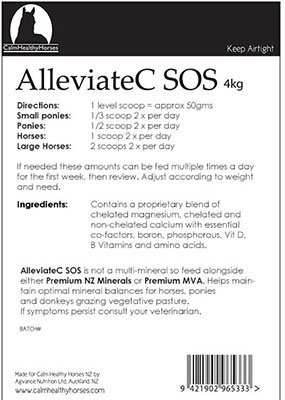SOS
For specific help for your horse, please contact me The best results have been observed when it has been used in conjunction with GrazeEzy along with our other recommended diet adjustments. While you are building up GrazeEzy, feed SOS high dose to overcome more serious issues. Once the horse is back to normal, gradually drop the amount. Keep some on hand for adding when necessary. For acute problems remove the horse from ALL green, grass until he is back to normal, then gradually and carefully reintroduce grass again. It is necessary to lower potassium intake by immediately removing from the horse’s diet:
- short, green, growing grass
- legumes like clover and lucerne
- soy-based feeds and protein meals
- molassed feeds
All of the above add to your horse’s potassium load and make it harder for his system to keep vital minerals in balance. He will still be ingesting plenty of potassium (more than his daily requirement) from his 24/7 hay.
$60.00 – $145.00
Directions
It needs to be introduced as per the directions on the back label. Start with a very little bit and increase every few days up to an amount where you can see a difference. The larger the horse the more this will be. For most horses this would probably be at least a scoop per day, for bigger horses on problem grass this could be up to 2 scoops am & pm.
Introducing slowly is very important because depending on individual requirements (size of horse, what sort of grass they are on, what the weather is doing), your horse may need to consume quite large amounts at times. This is why there is no set dose rate. The amount your horse needs will vary with the season and the weather – as a general rule of thumb, increase until your horse is back to normal. Thereafter you will likely need less over dry spells and more when it rains. Increase the dose when it starts to rain, rather than after the rain is finished and the horse is showing signs. Be pro-active.
Usage
- When the grass is part or all of your horse’s diet and it is green!
- When the hay isn’t ideal, meaning it is too ‘rich’ and still causing issues.
- If you are renting grazing and don’t have control over grass intake.


